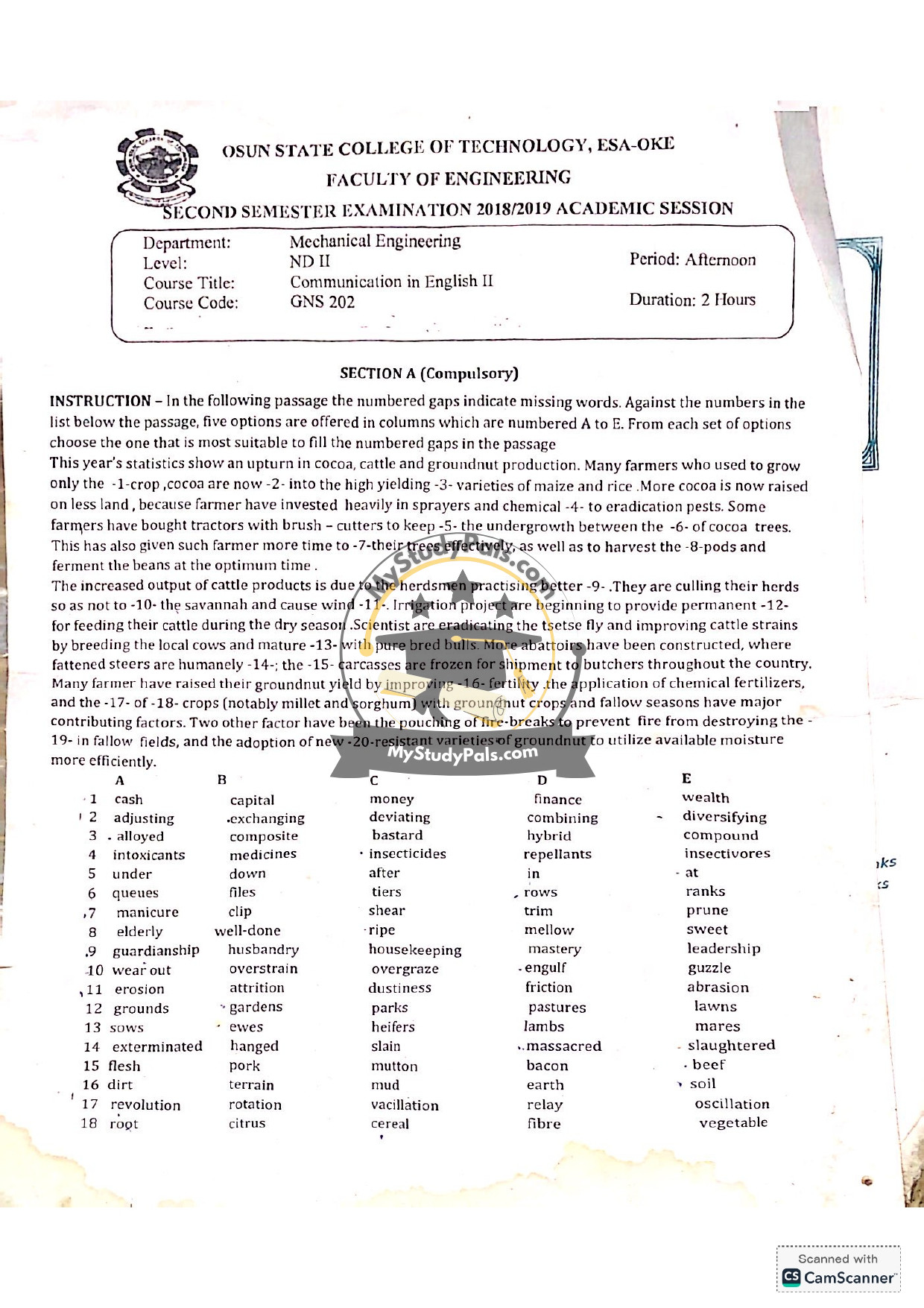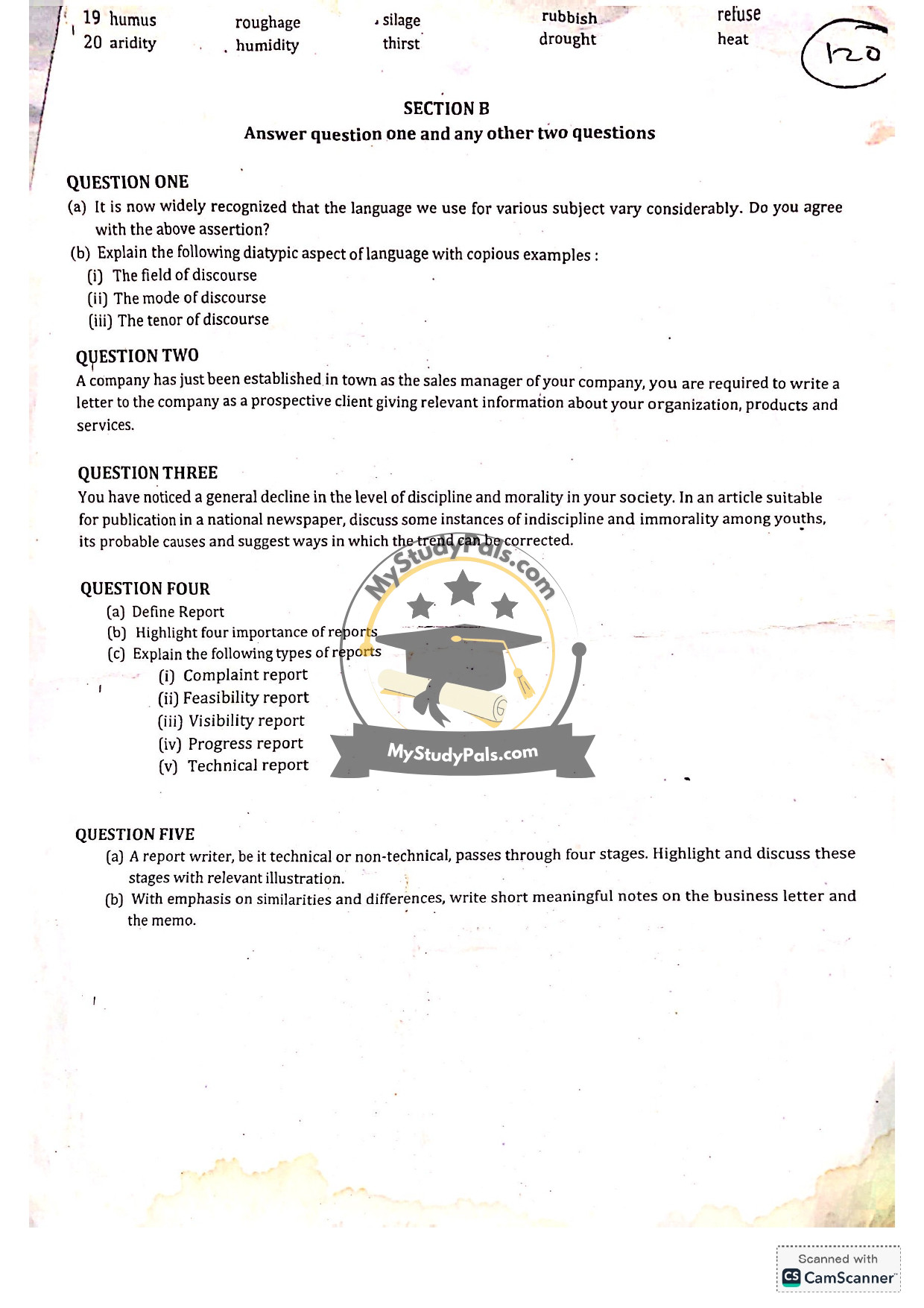ANWSER
SECTION A Answers
-1. A (cash)
-2. E (diversifying)
-3. D (hybrid)
-4. C (insecticides)
-5. B (down)
-6. D (rows)
-7. E (prune)
-8. C (ripe)
-9. B (husbandry)
-10. C (overgraze)
-11. A (erosion)
-12. D (pastures)
-13. C (heifers)
-14. E (slaughtered)
-15. E (beef)
-16. E (soil)
-17. B (rotation)
-18. C (cereal)
-19. A (humus)
-20. E (drought)
—
SECTION B Answers
Question 1(a):
Yes, I agree. The language used varies significantly across subjects. For instance, scientific fields employ technical jargon (e.g., “photosynthesis” in biology), while everyday communication uses simpler terms. Legal documents use formal, precise language, whereas creative writing prioritizes figurative expressions.
Question 1(b):
(i) Field of Discourse: Refers to the subject matter or topic. Example: Medical discussions use terms like “diagnosis” and “prognosis,” while engineering might use “torque” or “hydraulics.”
(ii) Mode of Discourse: Concerns the medium (written/spoken). Example: A lecture (spoken) uses conversational tone, while a research paper (written) is structured and formal.
(iii) Tenor of Discourse: Relates to the relationship between participants. Example: A manager addressing employees (formal) vs. friends chatting (informal).
—
Question 2 (Letter):
[Your Company’s Letterhead]
[Date]
The Sales Manager,
[New Company’s Name],
[Address].
Subject: Introduction to [Your Company’s Name] and Collaboration Proposal
Dear Sir/Madam,
We are pleased to introduce [Your Company’s Name], a leading provider of [products/services] specializing in [brief description, e.g., agricultural machinery]. Our offerings include [list key products], renowned for durability and innovation.
We propose a partnership to supply your organization with [specific products] tailored to your needs. Attached are catalogs and testimonials from satisfied clients. For inquiries, contact [phone/email].
We look forward to fostering a mutually beneficial relationship.
Yours faithfully,
[Your Full Name]
[Your Position]
[Your Company’s Name]
—
Question 3 (Article):
Title: Tackling Youth Indiscipline and Immorality: A Call to Action
Instances of indiscipline among youths, such as drug abuse, vandalism, and academic cheating, are alarming. Immorality, including cyberbullying and promiscuity, further exacerbates societal decay.
Causes:
– Erosion of parental guidance.
– Influence of social media and peer pressure.
– Economic hardships leading to frustration.
Solutions:
– Strengthen family values through community workshops.
– Integrate moral education into school curricula.
– Government initiatives to create youth employment.
Only collective effort can reverse this trend and nurture responsible future leaders.
—
Question 4(a):
A report is a structured document presenting factual information, analysis, and recommendations on a specific topic.
(b) Importance of Reports:
1. Facilitate informed decision-making.
2. Provide a permanent record of events.
3. Enable accountability and transparency.
4. Support problem-solving through data analysis.
(c) Types of Reports:
1. Complaint Report: Documents grievances (e.g., customer dissatisfaction).
2. Feasibility Report: Assesses project viability (e.g., cost-benefit analysis).
3. Visibility Report: Evaluates public awareness (e.g., marketing impact).
4. Progress Report: Tracks project milestones.
5. Technical Report: Details scientific/engineering processes.
—
Question 5(a):
Stages of Report Writing:
1. Planning: Define purpose, audience, and scope.
2. Research: Gather data via surveys, interviews, or literature.
3. Drafting: Organize findings into sections (introduction, methodology).
4. Revising: Edit for clarity, coherence, and correctness.
(b) Business Letter vs. Memo:
– Similarities: Both convey professional information.
– Differences:
– Format: Letters include addresses/salutations; memos use headers (To/From/Subject).
– Purpose: Letters target external parties; memos communicate internally.
– Tone: Letters are formal; memos are concise and direct.
—



